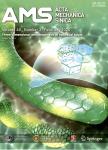Oxygen transfer in human carotid artery bifurcation
Oxygen transfer in human carotid artery bifurcation作者机构:Dalian University of Technology Dalian 116023 China Department of Bioengineering Beihang UniversityBeijing 100083 China
出 版 物:《Acta Mechanica Sinica》 (力学学报(英文版))
年 卷 期:2007年第23卷第3期
页 面:305-309页
核心收录:
学科分类:071011[理学-生物物理学] 0710[理学-生物学] 07[理学] 0802[工学-机械工程] 0701[理学-数学] 0801[工学-力学(可授工学、理学学位)] 0702[理学-物理学]
基 金:The project supported by the National Natural Science Research Council of China(10632010 10572017 30670517)
主 题:Atherosclerosis Carotid artery Secondary flow Mass transfer
摘 要:Arterial bifurcations are places where blood flow may be disturbed and slow recirculation flow may occur. To reveal the correlation between local oxygen transfer and atherogenesis, a finite element method was employed to simulate the blood flow and the oxygen transfer in the human carotid artery bifurcation. Under steady-state flow conditions, the numerical simulation demonstrated a variation in local oxygen transfer at the bifurcation, showing that the convective condition in the disturbed flow region may produce uneven local oxygen transfer at the blood/wall interface. The disturbed blood flow with formation of slow eddies in the carotid sinus resulted in a depression in oxygen supply to the arterial wall at the entry of the sinus, which in turn may lead to an atherogenic response of the arterial wall, and contribute to the development of atherosclerotic stenosis there.



